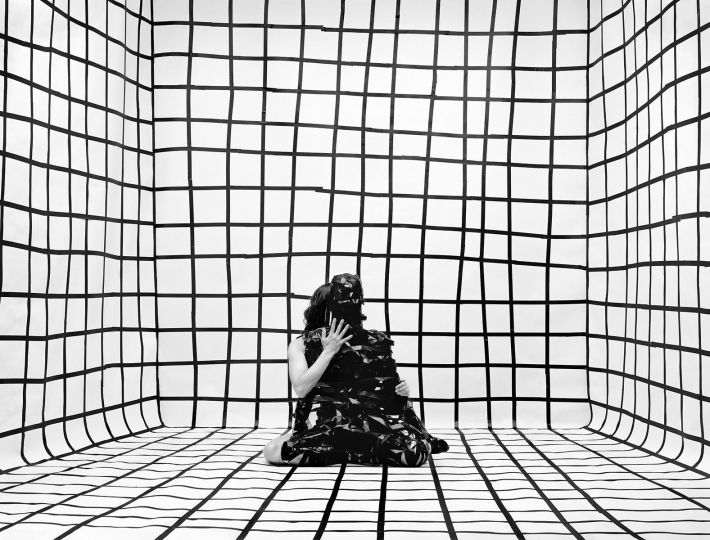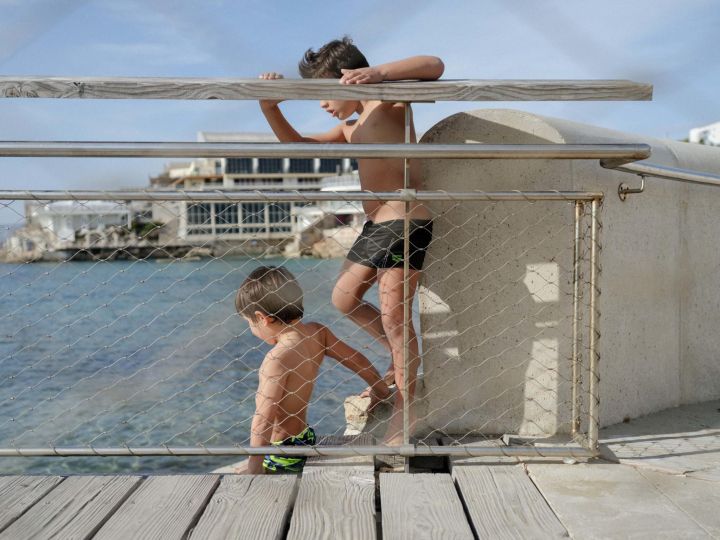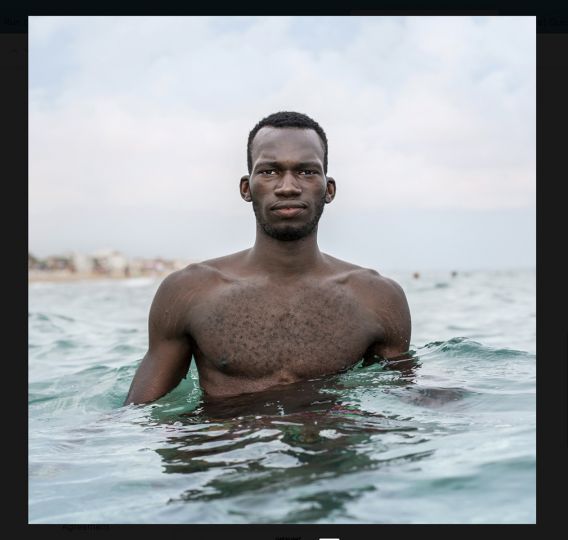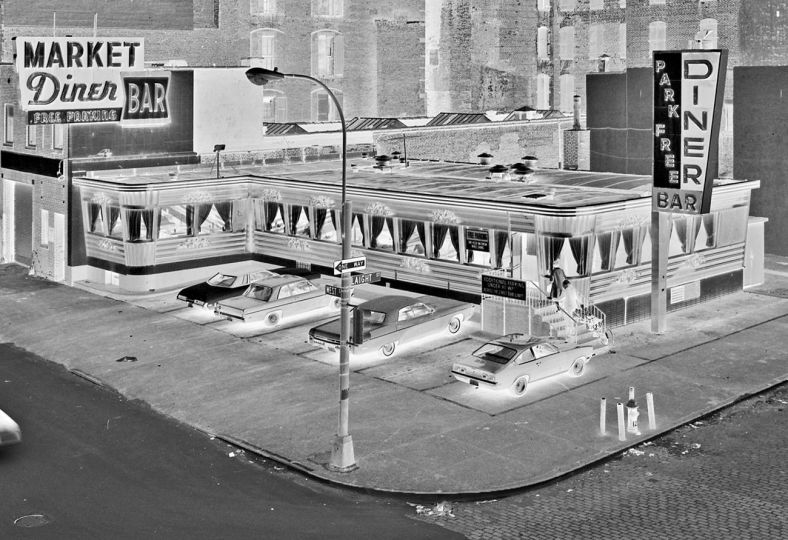A dreadful email when waking up yesterday morning.
Steve Hiett is dead! A few hours later, the confirmation by Julian Meijer his agent: Alas yes …
79 years old in the arms of Louise … cancer.
Steve was a formidable fashion photographer, full of talent and creativity. He was also a great artistic director. But in fact, Steve had only one passion: music.
Four years ago, we devoted a whole day to him: here it is!
Jean-Jacques Naudet
I remain convinced that if Steve Hiett’s foray into music fifty years ago had been a success, he wouldn’t have turned to photography. It’s fascinating to learn how certain photographers might easily have taken a different path: if Henri Cartier-Bresson had had the money to buy five cows, he would have married the village leader’s daughter and stayed in Africa; if Irving Penn and Guy Bourdin had enjoyed immediate success with their paintings, they wouldn’t have destroyed them and would have become painter. However, the only likeness we can really establish is between Bourdin and Hiett.
Steve is a fantastic photographer, and his forty years’ worth of images are still just as strong, just as uncompromising. On the release of his book – a truly stunning publication, with the text written by Philippe Garner – when I suggested we devote a day to him, his first reply was “Can we talk about music too?”
Jean-Jacques Naudet
“A Strange Beauty” by Philippe Garner
Steve Hiett’s name and story have been familiar to me since the mid-1960s. As a schoolboy in Brighton, I used to hear reports of his progress from his aunt, Jean, who was a family friend. A spinster, she took particular pride in her gifted nephew and would regularly reference him: ‘Steve is so talented’; ‘Steve has got himself a place in Brighton Art College’; ‘Steve makes wonderful art out of debris he finds on the beach’; ‘Steve has won a place at the Royal College of Art.’ I was already fascinated by the visual arts and ‘Steve’, as evoked by his aunt – for I had yet to meet him –, assumed a mythical status in my imagination. A few years older than me, while I was still dutifully pursuing my academic studies, Steve Hiett seemed to be enjoying great adventures and fulfilling the essence of my own ambitions to find a professional path in the arts .
I eventually met Steve in Paris in the 1970s, introduced by a mutual art director friend. Through the subsequent decades, I came to know his work well, and to understand the unique amalgam of perspectives that comprise its distinct character.
I have always enjoyed Steve’s company and our countless conversations reviewing shared interests in photography, art, music and graphic design, conversations which, like Steve’s creative work, always take us back to those magical formative years of the 1960s that shaped his aesthetic. For Steve is still at heart, all these years on, that same ever-curious and gifted art college student evoked by his proud aunt. If he has avoided falling out of fashion, it is because he has never been caught up in the ephemeral cycles of the fashion world. I hold Steve in high regard for the single-mindedness and wry modesty with which he has stayed true to himself, never compromising his creative integrity simply to reflect a trend in order to please a client or editor. He really is very good at being Steve Hiett, driven by his own primordial need to keep striving for the perfect picture, the ultimate layout as defined on his own terms.
Steve, whose work has been such a distinctive presence in fashion and style magazines for over forty years, has the rare ability to keep finding fresh variations within the strictures that he has made his own. The seeds of his signature approach are evident in two key early works that codify these parameters – in both cases projects without the otherwise ubiquitous girls who inhabit his imagination and pictorial universe; and these two precocious works are none the less telling for their absence. First is the maquette for a book he created as a project at Brighton Art College. The subject is the run-down streets behind the college. Steve acknowledges the influence of Roger Mayne, whose now-celebrated Southam Street photographs were first published in Uppercase 5 in 1961. Steve, like Mayne, found a poetry in the commonplace; furthermore, he was evidently already attuned to the making of impactful pages that effectively brought together images and bold typographic elements. Steve has never stopped replaying memories of his own childhood and adolescence in the modest, anonymous suburban streets of post-war Britain. The maquette is autobiographical at every level – in its non-glamour subject matter and in the formative photographic and design influences it reveals.
At first Steve’s vision was expressed in black and white. Then came his great step forward – colour, and his delight in the rich saturation of Kodachrome film. This new passion came to define his career, notably in the shades of blue that are immediately recognisable as his, and it found an early fulfilment in his first book, Pleasure Places, published in 1976, a celebration of the pictorial potential of everyday streets, now including generic American as well as British and other European locations, tightly framed, cleverly cropped into visual puzzles, metaphors in colour that play with the graphic potential of essentially banal motifs – the constant ingredients of Steve’s pictures. Pleasure Places is a sophisticated location scout’s ideas book for the low-key urban atmospherics and the expressive confluence of light, colour and form that set the scene in his fashion pictures.
Steve had moved to Paris in 1972 and very soon became one of the in-demand generation of fashion photographers who were earning a high international reputation for the city as a major creative centre. When, a couple of years later, a team of Japanese journalists came to report on the fashion photography scene for a special Paris issue of Commercial Photo (No. 26), Steve was among the roll call of featured photographers – alongside Alex Chatelain, Hans Feurer, Francis Giacobetti, Peter Knapp, Helmut Newton, Sarah Moon, Laurence Sackman and Jeanloup Sieff. Steve was in his element with the dominant ingredients of a graphically strong, intensely coloured chic that was redefining fashion imagery in the new decade – and that the Japanese team had, as outsiders, so shrewdly identified as expressing the mood of the moment.
Steve brought with him to Paris the rich resource of absorbed stimuli that have continued to inform his design work and picture-making. These embrace fine art sources – including early modernism, Pop Art and hard-edge abstraction – and a diverse array of graphic and typographic design references – among them Dadaist concrete poetry that collaged random ‘found’ typography, Constructivist poster design, surfer magazines, Blue Note album sleeves and the visual savviness of his Ulmtrained Royal College of Art tutor, Anthony Froshaug, whom he credits with teaching him how to lead the viewer’ s eye into or across a page.
A few years ago, Steve was able to acquire from a specialist bookseller a run of Ark, the Royal College of Art student-published journal that had reviewed, during his time at the college, so many of the topical art and design concerns that had shaped him. He was reminded of how indelible those influences had proved. Steve talks of his first exposure in the sixties to certain continental and American magazines and their impact on his understanding of how to construct pages, referencing, for example, the simple, strong typefaces that gave the pages of Paris Match such authority.
Of the many artists from whose work he took valuable lessons, Ellsworth Kelly might be singled out as a particular inspiration – in his toying with the ambiguities and visual tension of the negative and positive spaces within the picture plane, and in his dynamic , perfectly poised interpla y of flat areas of colour.
The sixties Pop explosion that radically transformed perspectives on what might be fitting subject matter for art, meanwhile, gave an impetus and legitimacy to shooting fashion in banal commercial and suburban settings; and the commonplace backdrop, particularly the American scene of car parks, diners, supermarkets and motels, provided limitless possibilities that perfectly matched the mood Steve sought to evoke. He was to travel regularly to the US to shoot fashion, and used Miami’s then run-down South Beach as his set, until the property speculators and fashion crowd turned it into a buzzing resort.
Wherever he travels, in the States or in Europe, he finds local, vernacular variations on an eternal theme. ‘Whether I take them in Paris or Miami, my photographs are middle-class stories of the suburbs; they are about being alone and dreaming,’ he once told me.
There is an implicit soundtrack to Steve’s visual world. He produced, some years ago, a small handmade book that comprised twenty-six photographic prints held together in a plastic spine. The cover offers a list of the contents: ‘One of my guitars / One of my photos / One of my favourite photos / Film clippings on a light box (21 versions) / Steve Hiett’. The clippings are an echo of photograms of the 1920s, or ‘action’ paintings of the 1950s; the favourite photograph is Bill Brandt’s famous ‘London, 1952’, a close-cropped wide-angle lens nude portrait that is a mysterious graphic cypher for erotic allure; his own picture is a wide-angle scene of three girls picnicking, with all the dislocated strangeness of a dark fragment from Alice in Wonderland; while the propped Fender guitar references Steve’s abiding passion for music, the music he assimilated as an adolescent and that resonates so powerfully for him to this day – from the incomparable riffs and driving power of Chuck Berry to the California pop of the Beach Boys, their emotive, sometimes joyous, sometimes poignant songs of teenage romance. Steve shuns the cult of personality, yet his story is there to be read within the la yers of his images.
Steve summed up for me recently the image that he has always strived to capture: ‘Strange, beautiful girls in strange, beautiful places in strange, beautiful light.’ And he added, ‘I know the intensity I’d like to produce. I hardly ever succeed.’ I would dispute only the latter claim. Steve’s pictures have a hold on us precisely because of the intense personal backstory that infuses them. They have content as well as arresting form. Steve’s photo-quest is the romantic pursuit of ideas that exist in his imagination.
He is in search of a mood, of an enigmatic feeling, of things that can only ever be hinted at, suggested, rather than defined. He manages very effectively to capture fragments of an ineffable storyline, the same scene played out time and again – of a girl just out of reach, of a promise yet to be fulfilled, the ‘femme cachée’, as he has dubbed her, who haunts his waking dreams. Steve laughed when, reflecting on the nature of this search, I likened his career to the destiny of Sisyphus, condemned endlessly to roll a boulder up a hill, only to see it roll back each time. He did not deny the comparison.
BOOK
Beyond Blonde
Steve Hiett
Essay by Philippe Garner
Edited by Patrick Remy
Prestel (November 9, 2015)
Hardcover, 280 pages
English
ISBN-13: 978-3791381800
60€
http://stevehiett.fr
















